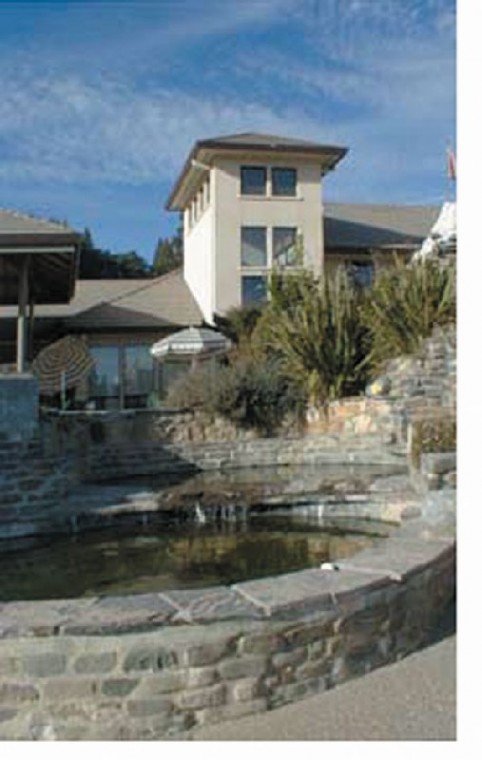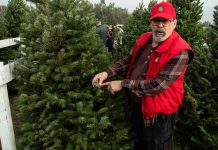Six-foot fences separating one neighbor from another is
something Ashish Martin-Zeavy doesn’t understand. Spending hours in
a car on a congested freeway just to get to work doesn’t make much
sense to him, either.
Six-foot fences separating one neighbor from another is something Ashish Martin-Zeavy doesn’t understand. Spending hours in a car on a congested freeway just to get to work doesn’t make much sense to him, either.
Which is why Martin-Zeavy, 25, lives and works in the Mount Madonna Center, a 355-acre community atop Mount Madonna in Watsonville.
The center, which bills itself an “intentional community,” is home to about 80 permanent residents as well as a number of temporary residents, who fluctuate throughout the year and stay anywhere between two days and six months. About 30 to 40 of the residents have lived at the center for 20 years or more.
The center is part of a larger movement known as co-housing, in which residents live in their own corridors but share everything from kitchen and dining space to bathrooms to recreational areas. Such communities originated in Denmark in the late 1960s and spread to North America in the late 1980s, according to The Co-housing Association of the United States.
Unlike communes, the concept behind co-housing communities supports individual residences but in a setting more social and interactive than typical suburban living. In addition to common areas, many communities share other services such as child care and carpooling to run in-town errands.
The Mount Madonna Center houses a broad mix of families with children, couples and singles, ranging in age from two to 80. Although general spiritual awareness is promoted, the center is not faith-based and is open to anyone who wants to apply.
While residents at the center live in separate rooms or homes, they share common dining areas, kitchens, meeting spaces, hiking trails, tennis courts, outdoor basketball courts, gardens, a lake, meditation hall, hot tub and gym. Most of the children attend Mount Madonna School, a private preschool through high school located on center grounds.
Residents also share meals, which are cooked with produce grown in the community garden. Vegetarian guidelines are enforced, and alcohol and tobacco are prohibited.
Most of the permanent residents are involved in the center’s work-exchange program, in which they spend 28 to 30 hours a week working at the center in exchange for food and lodging. Some tend to the center’s gardens, others do administrative work and still others help cook and clean. Work-exchange residents pay about $80 a month to cover other living expenses.
Martin-Zeavy, a teacher at Mount Madonna High School, has lived and worked in the community for almost four years. One of the best qualities of the community, he said, is that unlike suburbia, neighbors know each other beyond a courteous “hello.”
“It’s great because I live in nature. We’re in the redwood forests overlooking Monterey Bay, and it’s just beautiful,” he said. “I pay practically nothing to live here, and my food and housing is taken care of. My commute is a 10-minute walk, and along the way I see deer in the forests. I’m living in a community with animals, children and people of different generations.”
Communities like the Mount Madonna Center number more than three dozen in California with several in the Bay Area, according to the national association. Washington, Massachusetts and Colorado also are home to several communities.
The association also classifies the Franciscan Workers and Companions in Community in Salinas as a co-housing community. The organization, which is not faith-based, provides transitional services to those in need, such as a medical facility, soup kitchen and tutoring center. Residents usually stay for 18 to 24 months, said Robert Smith, who helped launch the organization 23 years ago.
“We’re a co-housing community in the sense that everything depends on how one defines that term,” he said. “The reasons people are here vary as much as much as the faces of our guests. We have proverbial Vietnam vets. Most of the men who are guests have fallen apart after relational breakups. Most of the women are dealing with life issues – everything from childhood sexual abuse to abandonment to addictions. And some folks are just down on their luck. They lost their jobs or their families are in transition from one locale to another.”
The Mount Madonna Center also is home to temporary residents, but in a different sense than the Salinas facility. Most of the center’s short-term residents stay anywhere between a weekend and six months, and during their stay, they participate in a number of programs encouraging self-expression, such as yoga, Buddhist meditation, creative dance and art.
The cost for temporary residents – which covers programs, food and lodging – is $500 for the first two months of residence, $250 for the next two months and $200 for the two months after that. Housing is available in rooms, cabins and developed campsites. Rooms are similar to hotel rooms but with no phones or television sets, and some have private bathrooms with showers while others have access to nearby, shared facilities. Cabins include electricity and heat, and residents use a separate shower house for bathing and dressing. Campsites also have access to shower houses.
Permanent residents live in homes, but they don’t own them – the community does, in an agreement called sponsored housing. If residents decide they want to live in the community on a permanent basis after living in short-term housing for several years, they can donate money to the community and in turn receive a home. Residents negotiate the price with one of the center’s several committees.
The difference between sponsored housing and private ownership is that once the resident moves out or dies, their home does not go on the market but instead goes back into the community for use as someone else’s home or to house one of the center’s program.
“Sponsored housing is ideal when an individual or family has a good, working relationship with the community, and their values and lifestyles are aligned with the community’s,” Martin-Zeavy said. “They know they want a long-term future in the community.”
Brajesh Friedberg, 66, has lived at the center since its inception 27 years ago. He said he enjoys living and working with hard-working people who aim to live their lives according to high values. His neighbors are more than neighbors, he said, participating together in everything from holiday celebrations to spirited games and activities.
Even so, living in the community doesn’t always come easy, Friedberg said.
“I always like to say, when you dance closely, you’re bound to occasionally step on one another’s toes,” he said. “When you live and work closely with people, it means you’re going to rub up against each other at times. … But no one would be here if they didn’t want to closely look at their own sensitivities and personal challenges and try to improve.”















